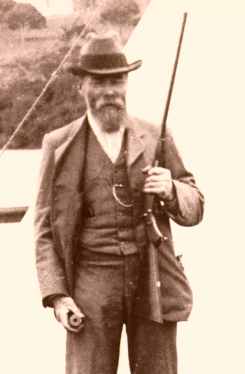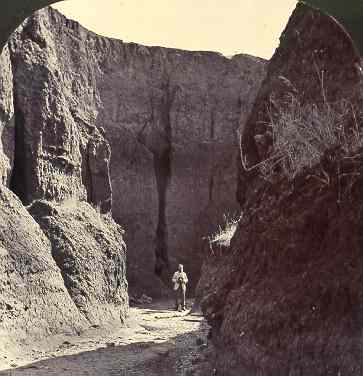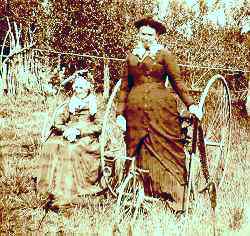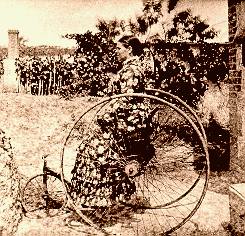 |
Henry Hammond TILBROOK founded the Northern Argus
newspaper at Clare in 1869 and for much of his life was an enthusiastic amateur
photographer who kept a record of his photographic activities. He was eighty-two years old
when he transcribed two copies of his notes, one for each of his two children, and
extracts from these have been used extensively throughout this file. Copies of his notes
and some of his albums, stereographs, enlargements and glass negatives are held by the
author.
(Text and images continue below) |
Henry Tilbrook was born in Llandudno, Wales, in 1848, and arrived in
South Australia with his parents on the Albermarle in 1854. He worked for a time as
a compositor at the Register office in Adelaide, then worked at the Arkaba Station
in the Far North until the pastoralists were driven out by the severe drought of 1865. On
the Paratoo run he was employed as a lamb-minder and shared a one-roomed hut with three
other men. ‘It had a doorway, but no door, and a window opening, but no window.’
There was only one bunk so three of them had to curl up on the earth floor at night.
‘Kangaroo rats ran over our prostrate forms, and perched upon us…’
Smitten with gold fever Henry went to New Zealand for two years where,
having no luck on the goldfields he worked for the Grey River Argus at Greymouth.
He was still a young man when he returned to South Australia and in February 1869, aged
21, he established the Northern Argus newspaper at Clare. On New Year’s Day in
1870, he married Marianne Clode at Christ Church, North Adelaide.
Below: The Northern Argus Office, Clare.

Henry became a keen and careful amateur photographer, and his interest
has been described by Solomon Williams (q.v.), the local tinsmith and ironmonger: ‘I
early made the acquaintance of Mr Tilbrook, and have numbered him amongst my friends since
that time. I found him a congenial companion, and in several directions his tastes were
similar to my own. He was fond of mechanics and of scientific study and invention. He
preceded me as an amateur photographer, and it was on account of his success that I was
induced to take up the art. This was the period when the "dry plate" system had
recently been introduced, which made it much easier for amateurs than the old "wet
plate" system was.
‘The printing paper then used was the albumenised paper and we had
to sensitise this by floating it on a bath of nitrate of silver solution and then fuming
with liquid ammonia. For years we worked together, comparing work and notes. At one period
we concentrated on stereoscopic pictures, and many drives have we had around the district
securing tit-bits of scenery, of which there is such a variety in the locality. Then
again, we were both fond of astronomy, and here again Mr Tilbrook preceded me in
construction of an astronomical telescope, and later assisted me in similar work.’
In September 1889 Henry Tilbrook and his friend Fred Lester, the local
AMP agent, went on a hunting trip to the Far North. At the time Henry was 41 years of age
and Fred Lester 26 years. Henry did not take his camera as the sole purpose of their trip
was to obtain euro skins for rug-making, but he later wrote, ‘I regretted the absence
of my camera.’
Henry later went on a number of photographic excursions with Fred Lester and others,
but usually left them and went off alone, or solus as he called it, carrying his heavy
camera gear in search of suitable subjects. Photographic excursions he mentions in his
writings and included here were:
1894 - The Flinders Ranges
1898 - To Mount Gambier and district
1899 - To the top of Mount Bryan, north of Burra.
1900 - Back to the South East
1905 - Mount Gambier and Portland, Victoria.To read about any of the above
excursions, and to view some of the photographs Henry made on the trip, make your
selection from the menu on the left. |
 |
Left:
Henry Tilbrook is not seen in his photographs of the Flinders Ranges trip. However, before
his next excursion he made a remote control device with which he could trip the shutter on
his tripod-mounted camera. He often mentions this device in his writings and he is seen
here using his fingers to wind up the reel of thread which was connected to his camera so
that he could be included in the photographs. |
SOME OF HENRY TILBROOK’S PHOTOGRAPHS
Below: ‘Lizzie Smelat’ -- One half of a
stereo pair. Most of Henry Tilbrook’s photographs are of scenery.
This portrait is one of three stereos of the same lady taken indoors, date and location
unknown.

Below: ‘Neagles Rock, Clare. H.H. Tilbrook.
Photo.’ One half of a stereo pair.

 |
Left: ‘A canyon, Blyth Plains.’
One half of Henry Tilbrook’s stereo pair. Soil erosion near Kybunga, c.1900. |
Below: ‘Old Burra Smelting Works showing
Stack.’ Enlarged section of one half of Henry Tilbrook’s stereo pair, c.1900.

Below: Another view of the Old Burra Smelting Works c.1900. From one half
of a stero pair.

Below: An ancient form of tricycle, the velocipede. Sections from Henry
Tilbrook's stereographs.

END.










